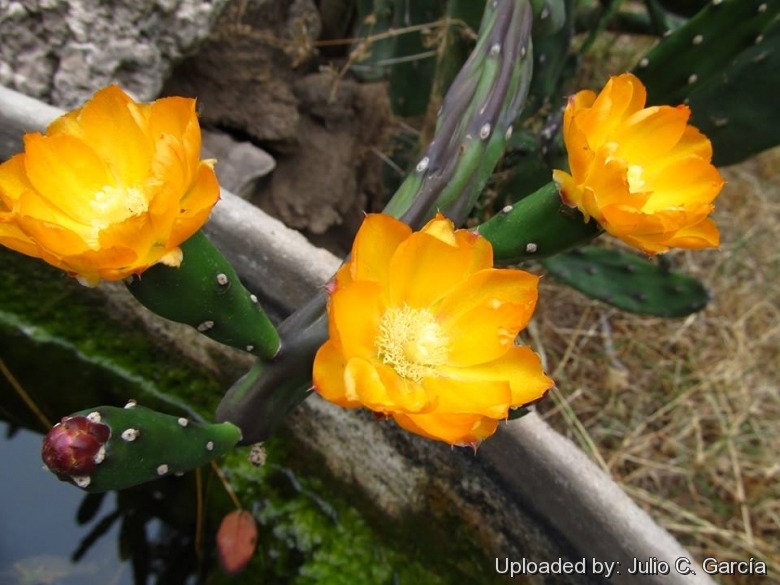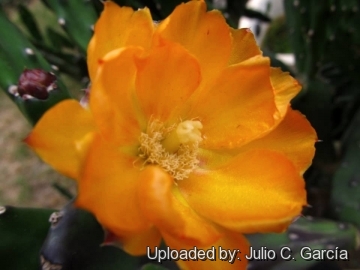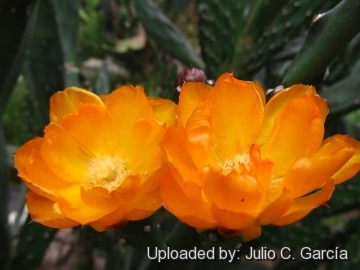Accepted Scientific Name: Opuntia anacantha var. kiska-loro (Speg.) R.Kiesling
Candollea 53: 475. 1998

Opuntia kiska-loro (Opuntia anacantha var. kiska-loro) Photo by: Julio C. García
The joints typically bears sharp spines, but the spineless forms (by some considered a orange flowered {{Opuntia anacantha}}) appear to be the more common in cultivation.
Origin and Habitat: Opuntia anacanthaSN|28385]]SN|28385]] var. kiska-loro occurs in the far north-west part of Argentina into Bolivia.
Type locality: Deserts of La Rioja, Catamarca, Argentina.
Synonyms:
See all synonyms of Opuntia anacantha
Common Names include:
ENGLISH: Spineless cactus, Orange Tuna Cactus
SPANISH (Español): Quisca- loro
Description: Opuntia anacanthaSN|28387]]SN|28385]] var. kiska-loro (a.k.a. Opuntia kiskaloro) is one of the controversial varieties (or distinct species) belonging to the Opuntia anacanthaSN|28385]]SN|28385]] group. Opuntia anacanthaSN|28385]]SN|28385]] var. kiska-loro unlike the main species has light green linear-oblong pads and orange only flowers (not yellow). The joints typically bears sharp spines, but a spineless forms (by some considered a orange flowered Opuntia anacantha) appear to be the more common in cultivation.
Remarks: This species presents a large morphological variability, also within the same population and on individuals living a few meters from each other and sometimes even on the same specimen. This accounts for the numerous controversial synonyms and make classification extremely questionable.
Description in Brighton & Rose "The Cactaceae" Vol I, page 108 1919 28385]SN|28387]] Spegazzini: Prostrate, rooting, forming spreading clumps 3 to 6 dm. high; joints flat, at first
very narrow, becoming lanceolate, 20 cm long, 4 cm. broad, shining green.
Spines: 2 to 4, unequal, whitish, 4 to 6 cm long.
Flowers: Orange, rather large, 3 to 6 cm. broad. Filaments pale orange. Stigma-lobes 6, flesh-coloured.
Fruit: 5 cm. long, deep violet-purple without, white within.
Seeds: mm. broad, pubescent.
Subspecies, varieties, forms and cultivars of plants belonging to the Opuntia anacantha group
- Opuntia anacantha Speg.: (var. anacantha) has dark green stem segments usually spineless and yellow flowers. Distribution: Southern Gran Chaco region of Argentina.
 Opuntia anacantha var. kiska-loro (Speg.) R.Kiesling: has light green stem segments and orange flowers. Distribution: far north of Argentina into Bolivia.
Opuntia anacantha var. kiska-loro (Speg.) R.Kiesling: has light green stem segments and orange flowers. Distribution: far north of Argentina into Bolivia.  Opuntia anacantha var. retrorsa (Speg.) R.Kiesling: has light green stem segments with sharp spines turned backward and has violet stripes downwards from the areoles. Flowers are yellow. Distribution: grassland in southern part of the range, Argentina.
Opuntia anacantha var. retrorsa (Speg.) R.Kiesling: has light green stem segments with sharp spines turned backward and has violet stripes downwards from the areoles. Flowers are yellow. Distribution: grassland in southern part of the range, Argentina.- Opuntia anacantha var. utkilio (Speg.) R.Kiesling: has elliptical, green stem segments and yellow flowers. Distribution: near Tucuman, Argentina.
Bibliography: Major references and further lectures
1) Edward F. Anderson “The Cactus Family” Timber Press, 2001
2) Opuntia kiska-loro Speg., Anales Mus. Nac. Buenos Aires 11 (ser. 3, 4): 516. 1905.
3) Brighton & Rose "The Cactaceae" Vol I, page 108 1919 [21 Jun 1919]
4) David Hunt, Nigel Taylor “The New Cactus Lexicon” DH Books, 2006
 Spineless form (cultivated) (Opuntia anacantha var. kiska-loro) Photo by: Julio C. García
Spineless form (cultivated) (Opuntia anacantha var. kiska-loro) Photo by: Julio C. García Spineless form (cultivated) (Opuntia anacantha var. kiska-loro) Photo by: Julio C. García
Spineless form (cultivated) (Opuntia anacantha var. kiska-loro) Photo by: Julio C. GarcíaCultivation and Propagation: Opuntia kiska-loroSN|28387]]SN|28387]] is a a much decorative cactus not very common in cultivation. It is a summer grower species that offers no cultivation difficulties.
Soil: Use a very a particularly draining substratum, as it is sensitive to rottenness when in presence of humidity and low temperatures and let the soil dry out between waterings, since it's natural habitat is in sandy or gravelly, well draining soils.
Repotting: Repot in the spring, when their roots become cramped. Generally, they should be repotted every other year in order to provide fresh soil. After repotting, do not water for a week or more.
Water: In summer, during the vegetative period, it must be regularly watered, but allowing the substratum to completely dry up before irrigating again (but do not overwater ); in winter, it’s to be kept dry. Preferable not to water on overcast days, humid days or cold winter days.
Hardiness: It is a quite frost resistant cactus, hardy to -7° C. However in cultivation it is better not to expose it to temperatures lower than -0° C, even if in an aerated and protected location, in order to avoid the formation of anti-aesthetic spots on the epidermis. In presence of high atmospheric humidity avoid any frost as it is particularly sensitive to root rot. USDA Zone 7-10. It can handle extremely high temperatures in summer.
Exposure: Outside full sun or afternoon shade, inside needs bright light, and some direct sun.
Use: It is suitable for “desert” gardens, in association with other xerophytes. Where the open air cultivation is not possible due to the climate, it is to be cultivated in pot in order to shelter it in winter.
Warning: It is armed with treacherous spines that are extremely sharp. Handle it with caution, and keep it away from gangways and areas frequented by children and animals. Spines must be meticulously removed with tweezers.
Propagation: Stem division. Prickly pear pads root easily and grow rapidly when placed in loose, well-draining soil.












